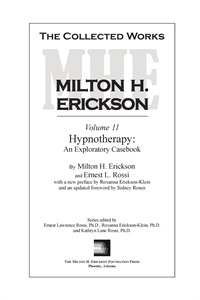The Collected Works of Milton H. Erickson: Volume 11 - Hardcover: Hypnotherapy: An Exploratory Casebook
- Average Rating:
- Not yet rated
- Topic Areas:
- Hypnotherapy | Milton Erickson
- Categories:
- Featured | The Collected Works
- Author:
- Roxanna Erickson Klein, RN, PhD, LPC, LCDC | Ernest Rossi, PhD | Kathryn Rossi, PhD
- Copyright:
-
2013
- Publisher:
- The Milton H. Erickson Foundation Press
- Number of Pages:
- 495
- License:
- Never Expires.
Tags: Hypnotherapy Hypnosis
Description
In my original Foreword to this volume I expressed the opinion that, with Milton Erickson, Ernest Rossi “has done the best job to date in clarifying Erickson’s ideas on the nature of hypnosis and hypnotic therapy, on techniques of hypnotic induction, on ways of inducing therapeutic change and of validating this change.” Many books have been written about Erickson’s approaches to therapy in the 33 years that have passed since this book was published, yet I will still stand with that opinion. On reading or re-reading this book and others, edited by or co-written by Ernest Rossi we cannot fail to be impressed by Rossi’s ideas, about the Utilization Approach and the development of new frames of reference, for example. These ideas have become so accepted in different approaches to psychotherapy that they seem to have been obvious and to have existed forever. We are especially struck by Erickson’s incredible, sometimes exquisite use of words. As Paul Watzlawick has noted Erickson “heals with words.” —Sidney Rosen, MD
Table of Contents
- The Utilization Approach to Hypnotherapy
- Preparation
- Therapeutic Trance
- Ratification of Therapeutic Change
- Summary
- Exercises
- Chapter 2. The Indirect Forms of Suggestion
- Direct and Indirect Suggestion
- The Interspersal Approach
- Indirect Associative Focusing
- Indirect Ideodynamic Focusing
- Truisms Utilizing Ideodynamic Processes
- Ideomotor Processes
- Ideosensory Processes
- Ideoaffective Processes
- Ideocognitive Processes
- Truisms Utilizing Time
- Not Knowing, Not Doing
- Open-Ended Suggestions
- Covering All Possibilities of a Class of Responses
- Questions That Facilitate New Response Possibilities
- Questions to Focus Associations
- Questions in Trance Induction
- Questions Facilitating Therapeutic Responsiveness
- Compound Suggestions
- The Yes Set and Reinforcement
- Contingent Suggestions and Associational Networks
- Apposition of Opposites
- The Negative
- Shock, Surprise, and Creative Moments
- Implication and the Implied Directive
- The Implied Directive
- Binds and Double Binds
- Binds Modeled on Avoidance-Avoidance and Approach-Approach Conflicts
- The Conscious-Unconscious Double Bind
- The Double Dissociation Double Bind
- Multiple Levels of Meaning and Communication: The Evolution of Consciousness in Jokes, Puns, Metaphor, and Symbol
- Exercises
- The Utilization Approach: Trance Induction and Suggestion
- Accepting and Utilizing the Patient’s Manifest Behavior
- Utilizing Emergency Situations
- Utilizing the Patient’s Inner Realities
- Utilizing the Patient’s Resistances
- Utilizing the Patient’s Negative Affects and Confusion
- Utilizing the Patient’s Symptoms
- Exercises
- Posthypnotic Suggestion
- Associating Posthypnotic Suggestions with Behavioral Inevitabilities
- Serial Posthypnotic Suggestions
- Unconscious Conditioning as Posthypnotic Suggestion
- Initiated Expectations Resolved Posthypnotically
- Surprise As a Posthypnotic Suggestion
- Exercises
- Altering Sensory-Perceptual Functioning: The Problem of Pain and Comfort
- Case 1. Conversational Approach to Altering Sensory-Perceptual Functioning: Phantom Limb Pain and Tinnitus
- Case 2. Shock and Surprise for Altering Sensory-Perceptual Functioning: Intractable Back Pain
- Case 3. Shifting Frames of Reference for Anesthesia and Analgesia
- Case 4. Utilizing the Patient’s Own Personality and Abilities for Pain Relief
- Selected Shorter Cases: Exercises for Analysis
- Symptom Resolution
- Case 5. A General Approach to Symptomatic Behavior
- Session One:
- Part One. Preparation and Initial Trance Work
- Part Two. Therapeutic Trance as Intense Inner Work
- Part Three. Evaluation and Ratification of Therapeutic Change
- Session Two:
- Insight and Working Through Related Problems
- Session One:
- Case 6. Demonstrating Psychosomatic Asthma with Shock to Facilitate Symptom Resolution and Insight
- Case 7. Symptom Resolution with Catharsis Facilitating Personality Maturation: An Authoritarian Approach
- Case 8. Sexual Dysfunction: Somnambulistic Training in a Rapid Hypnotherapeutic Approach
- Part One. Facilitating Somnambulistic Behavior
- Part Two. A Rapid Hypnotherapeutic Approach Utilizing Therapeutic Symbolism with Hand Levitation
- Case 9. Anorexia Nervosa
- Selected Shorter Cases: Exercises for Analysis
- Case 5. A General Approach to Symptomatic Behavior
- Memory Revivication
- Case 10. Resolving a Traumatic Experience
- Part One. Somnambulistic Training, Autohypnosis, and Hypnotic Anesthesia
- Part Two. Reorganizing Traumatic Life Experience and Memory Revivication
- Case 10. Resolving a Traumatic Experience
- Emotional Coping
- Case 11. Resolving Affect and Phobia with New Frames of Reference
- Part One. Displacing a Phobic Symptom
- Part Two. Resolving an Early-Life Trauma at the Source of a Phobia
- Part Three. Facilitating Learning: Developing New Frames of Reference
- Selected Shorter Cases: Exercises for Analysis
- Case 11. Resolving Affect and Phobia with New Frames of Reference
- Facilitating Potentials: Transforming Identity
- Case 12. Utilizing Spontaneous Trance: An Exploration Integrating Left and Right Hemispheric Activity
- Session 1: Spontaneous Trance and its Utilization: Symbolic Healing
- Session 2:
- Part One. Facilitating Self-Exploration
- Part Two. Automatic Handwriting and Dissociation
- Case 13. Hypnotherapy in Organic Spinal Cord Damage: New Identity Resolving Suicidal Depression
- Case 14. Psychological Shock and Surprise to Transform Identity
- Case 15. Experiential Life Review in the Transformation of Identity
- Case 12. Utilizing Spontaneous Trance: An Exploration Integrating Left and Right Hemispheric Activity
- Creating Identity: Beyond Utilization Theory?
- Case 16. The February Man
Credits
Author

Roxanna Erickson Klein, RN, PhD, LPC, LCDC Related Seminars and Products
Roxanna Erickson Klein, RN, PhD, is a registered nurse for more than 40 years, Roxanna has a passion for the interface for psychological and physical medicine. She has special training in the treatment of recovery from chemical dependency and is currently working on a license in counseling.

Ernest Rossi, PhD Related Seminars and Products
Ernest L. Rossi, PhD, is an internationally renowned therapist, teacher and pioneer in the psychobiology of mind-body healing. The author of more than 24 professional books, Dr. Rossi worked with Milton Erickson for eight years and co-authored three classic volumes on therapeutic hypnosis with him. Rossi has also edited four volumes of Erickson's Collected Papers and four volumes of Erickson's Seminars, Workshops and Lectures. He has been conducting research in the psychosocial genomics of ultradian rhythms and their relation to mind-body healing and psychotherapy for over three decades.

Kathryn Rossi, PhD Related Seminars and Products
Kathryn Rossi, Ph.D, is a licensed psychologist and certified yoga instructor (RYT 500). She recently co-edited the 16-volume Collected Works of Milton H. Erickson. She and Ernest Rossi are in private practice in Los Osos, Calif.


